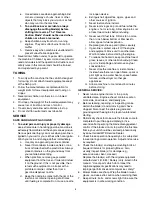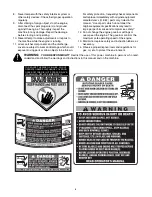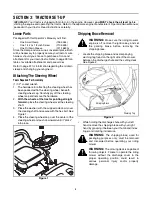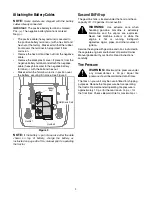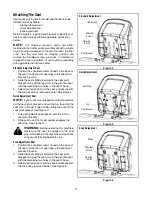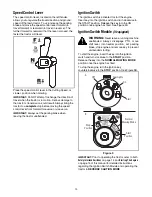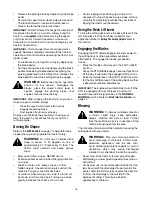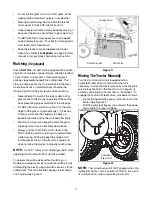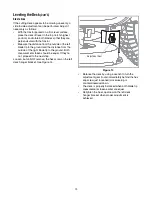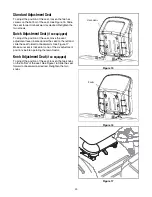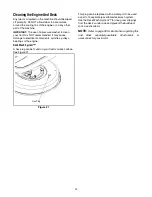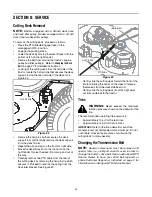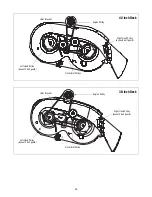
17
•
Do not cut the grass too short. Short grass invites
weed growth and yellows quickly in dry weather.
•
Mowing should always be done with the throttle
control lever to the FAST (rabbit) position.
•
Under heavier conditions it may be necessary to go
back over the area a second time to get a clean cut.
•
Do NOT attempt to mow heavy brush and weeds
and extremely tall grass. Your tractor is designed to
mow lawns, NOT clear brush.
•
Keep the blades sharp and replace the blades
when worn. Refer to
Cutting Blades
on page 26 of this
manual for proper blade sharpening instructions.
Mulching
(if equipped)
Some,
NOT ALL
, models come equipped with a mulch
kit which incorporates special blades, already standard
on your tractor, in a process of recirculating grass
clippings repeatedly beneath the cutting deck. The
ultra-fine clippings are then forced back into the lawn
where they act as a natural fertilizer. Observe the
following points for the best results when mulching.
•
Never attempt to mulch if the lawn is damp. Wet
grass tends to stick to the underside of the cutting
deck preventing proper mulching of the clippings.
•
Do NOT attempt to mulch more than 1/3 the total
height of the grass or approximately 1-1/2 inches.
Doing so will cause the clippings to clump up
beneath the deck and not be mulched effectively.
•
Maintain a slow ground speed to allow the grass
clippings more time to effectively be mulched.
•
Always position the throttle control lever in the
FAST (rabbit) position and allow it to remain there
while mowing. Failing to keep the engine at full
throttle places strain on the tractor’s engine and
does not allow the blades to properly mulch grass.
NOTE:
Do NOT remove the discharge chute when
operating the mower with the mulch kit installed.
To operate the cutting deck without mulching, on
models so equipped, simply remove the mulch plug by
unthreading the plastic wing nut which secures it to the
cutting deck. This will allow the clippings to discharge
out the side. See Figure 11.
Figure 11
Moving The Tractor Manually
Your tractor’s transmission is equipped with a
hydrostatic relief valve for occasions when it is
necessary to move the tractor manually. Activating this
valve forces the fluid in the transmission to bypass its
normal route, allowing the rear tires to "freewheel." To
engage the hydrostatic relief valve, proceed as follows:
•
Locate the hydrostatic bypass rod in the rear of the
tractor. See Figure 12.
•
Pull the hydrostatic bypass rod outward, then down
and to the left, to lock it in place.
Figure 12
NOTE:
The transmission will NOT engage when the
hydrostatic bypass rod is pulled out. Return the rod to
its normal position prior to operating the tractor.
Carriage Screw
Plastic Wing Nut
Mulch Plug
Hydrostatic
Bypass Rod
Summary of Contents for 791
Page 29: ...29 NOTES ...
Page 30: ...30 NOTES ...



